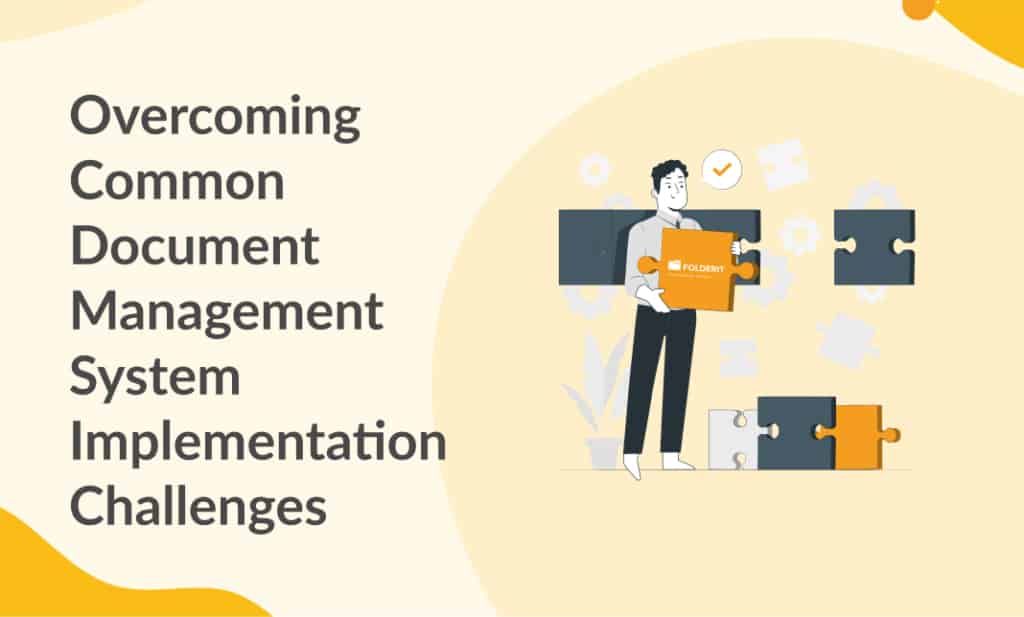Implementing a Document Management System (DMS) can be a transformative move for businesses, unlocking efficiencies and safeguards previously unattainable with traditional document handling. However, the path to successful implementation can be fraught with challenges, many of which are common across various industries and company sizes. Recognizing and effectively navigating these challenges are crucial to unlocking the full benefits of a DMS.
Understanding the Common Challenges
Technical Difficulties
The transition from manual or semi-digitalized processes to a fully-fledged DMS can be technically challenging. Migrating data, setting up the DMS software, and integrating it with existing systems requires technical expertise and meticulous planning.
Budget Constraints
Not all organizations have the financial capacity for an expensive, upfront software investment. It’s a common struggle, especially for small and medium enterprises and nonprofits.
Employee Training
Staff may resist change due to the perceived complexity of the new system. Effective training and change management strategies are essential to ensure smooth adoption.
Security Concerns
The move to a digital system often raises concerns about the security of sensitive documents, especially if the solution is cloud-based.
Navigating the Challenges: Practical Solutions
Managed Implementation
Businesses may lack in-house expertise for a smooth DMS transition. In this case, consider partnering with a DMS provider offering managed implementation services. They can guide you through technical setup, data migration, and system integration.
Subscription-Based DMS
Budget constraints can make the initial investment in DMS daunting. A cloud-based, subscription model like Folderit is a viable solution. It offers flexibility and scalability, with the added advantage of no significant upfront cost. Organizations can choose a plan that suits their needs and scale up as required.
Effective Employee Training
Any new system necessitates a learning curve for the users. Plan structured training sessions, create easy-to-understand guides, and ensure ample support during the initial stages of adoption. The goal is to foster a supportive environment where employees feel encouraged to engage with the new system.
Secure Cloud-Based Solution
Fears regarding document security are valid but can be mitigated with a secure cloud-based solution. According to recent research, a secure cloud environment can often be more secure than on-premise solutions. It provides benefits such as encryption, round-the-clock security monitoring, and automatic updates to bolster your defense against cyber threats. Folderit is a prime example, offering bank-level, 256-bit encryption for utmost security.
Embracing a Strategic Approach to DMS Implementation
Successfully overcoming DMS implementation challenges requires strategic planning, open communication, and partnership with a reliable DMS provider. Businesses must acknowledge the potential hurdles and prepare accordingly.
Here are some further tips to ensure a successful DMS implementation:
Plan Thoroughly
Define clear goals, set realistic timelines, and allocate resources appropriately. Make sure the chosen DMS aligns with your business requirements and has the capacity to grow with your organization.
Involve End Users Early On
Engage employees during the selection process. Their input can be invaluable as they are the ones who will use the system daily. Their early involvement will also foster a sense of ownership, aiding smoother adoption.
Prioritize Security
While opting for a DMS, review its security features meticulously. Features like encryption, access control, audit trails, and two-factor authentication are vital.
A Step-By-Step Approach
Don’t rush the implementation. Roll out the system in phases, starting with less critical functions. This approach reduces disruption and allows for necessary adjustments along the way.
Continuous Improvement
The DMS implementation process does not end with the system going live. Regular reviews and updates are essential to ensure that the system continues to meet the organization’s evolving needs.
Organizational Change with a Growth Mindset for the Digital Age
Moving to a digital document management system signifies a major change in any organization’s operations. Change can be intimidating, but it’s essential to remember the extensive benefits that a well-implemented DMS brings. By facilitating document accessibility, improving collaboration, ensuring robust security, and simplifying regulatory compliance, a DMS paves the way for enhanced operational efficiency. Additionally, advanced solutions like Folderit also offer extensive customization options, ensuring the DMS fits the unique needs of your organization.
Remember, successful implementation is not a singular event but a process. It involves not just the integration of new software but also the adaptation of the organization’s culture and workflows. Engage your team early in the process, involve them in decision-making and problem-solving, and invest in their training. When staff understand the benefits and feel involved in the process, they’re more likely to embrace the new system and contribute positively to its successful implementation.
Turning Challenges into Opportunities
While the journey towards implementing a DMS may appear challenging, these obstacles can be transformed into opportunities for growth. By identifying potential issues, creating strategic plans to address them, and leveraging the expertise of a trusted DMS provider like Folderit, organizations can greatly ease the transition process. Remember, the goal is not merely to implement a new system, but to cultivate a digital mindset that opens the door to continual improvement and innovation. With the right approach, the challenges of DMS implementation become stepping stones to a more productive, secure, and efficient future.



